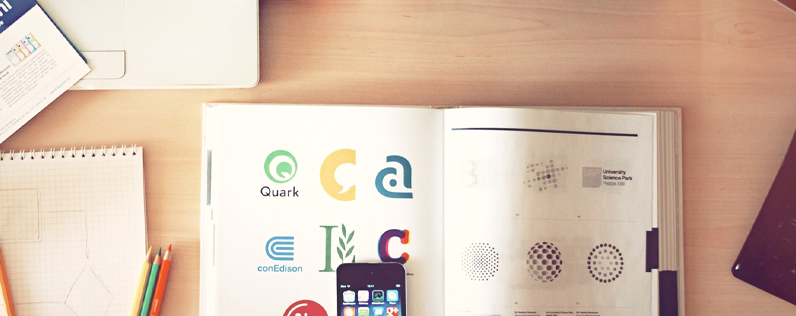When you see the famous golden arches from the freeway, you suddenly crave salty french fries. You know that an apple with a bite in it is a symbol of modernity and technology. And of course, someone rocking the famous swoosh means they’re either coming from (or going to) the gym. McDonald’s, Apple, and Nike pour millions into their branding efforts each year, yet no single marketing campaign will have as big of an impact as the central image: their logo, also known as their brand identity. As a business, brand, creative, or influencer, you probably want to have that same effect.

Step-by-step: How to design a logo
The logo design process is one that heavily involves creativity and trial and error. You are creating an image that will represent and encompass all of your brand and represent your target audience. Much like how the shape of a heart is a symbol of love, friendship, and togetherness, your brand logo will be a symbol for your company, your brand, and you.
It’s a lot of pressure to put on a single image. But that’s okay; that’s why this designing a logo guide is here.
So, get your markers, pencils, paper, and thinking cap ready, because here are the six steps to designing any logo.
Step 1: The ideation process
To create a perfect logo, first, you must expel all of the (imperfect) design ideas from your brain. Some call this brainstorming. Some call this ideation. Others call this doodling. And doodling is exactly what you should be doing.
Start with the name of your company or your name
Are there any images that come to mind? Draw them out. Write the name in large letters; write it in cursive. Try block letters and lowercase letters and then just write the initials. What do you like? What do you not like?
Think of what you do or what your business does
Again, think in images here. What pictures sum up what you do? If you own a barbershop, maybe it’s a pair of scissors. If you have a YouTube channel that’s famous for unboxing items, maybe it’s simply a box with the top popped off.
Combine the two together
Start to play with the letters of your name or company. Can the letter create an image of what your business does? Is there a way to blend them into one striking image that describes both the name and purpose of the company?
Set a timer
Spend five, 10, 15, or even 30 minutes in the ideation process. Don’t stop doodling until the timer goes off. Remember, draw big, draw small, draw curly and blocky, draw weird, and try only using straight lines. The point is not to judge (that’s for later); the point is to get the ideas from your head onto the page.
When your timer is up, you may not have created your or your business’ equivalent of the swoosh. That’s okay. The purpose of the ideation design process isn’t to be done, it’s to get started. You need a roadmap of what you like and what you don’t like. Eventually, you will have to settle on an image, word(s), and color.
The last thing you want to do is get stuck staring at a blank page.
Warning: Designer’s block is real
There’s one thing that will stop this process dead in its tracks: designer’s block.
This is when looking at a blank page becomes a staring contest with the blank page. And this will inevitably lead to frustration and (of course) zero logos being created. To avoid this, you have to mark up the page. The logo design tips above intend to get your brain and your hands moving (much like stretching before exercising).
Step 2: Put together a book of inspiration
Your book of inspiration will consist of images, photos, other company logos that you like, color palettes, and more. These will start to shape what you want in your own design. This could consist of:
Finding other company logos
This process might take some time depending on how you do your research. You can either search through competitor sites and find the ones you like (and dislike), or you can go on a walk. Notice any billboards, storefronts, magazine logos, and snap a picture with your phone. From there, you can start to pick apart what you like and what you don’t like.
Not sure where to start? Here are five nonprofits that not only have a great logo but have a great brand messaging behind it.
The mood board
The mood board is a bit of a joke amongst designers. It’s incredibly useful, yet it’s hard for non-designers to understand its utility. The mood board will consist of finding images that answer the following questions:
- What kind of animal do you see your brand or your company as?
- What type of day (sunny, cloudy, thunderstorm) is your brand?
- What type of plant encapsulates your brand?
- What colors come to mind when you think about your brand?
- What are the tools you use within your company or brand?
As you start to gather pictures and colors, put them on a physical poster board, or create a digital mood board. Soon you’re going to have animals, environments, plants, tools, and colors all in one place. This helps you hone in on your logo, your brand, and what you’re trying to accomplish. (Perhaps you can see why non-designers have a hard time seeing the importance: What do you mean by my company as an animal? Trust us, it helps!)
Combine the two into your book of inspiration
Again, this can be a digital book of inspiration or a physical one. By having a collection of what you like and what you don’t like, you will be able to identify pieces of how you should build up your logo.
At this point in your logo-building journey, you might notice that the initial sketches in your ideation process are starting to stand out — for better or for worse. As you spend this time researching what you like and dislike about company logos (and continue thinking of your own brand in unique ways), more ideas might spring into your imagination. Be sure to jot them down!
During this process, having a small journal in your pocket at all times will come in handy.
Step 3: Choosing the aesthetic and tone
For many of you, you’re still waiting for that aha! moment — that feeling when you know you’ve stumbled upon the image that encapsulates both your brand and you. To help get you one step closer, let’s review some major aesthetics and tones.
- Minimalism – Small thin lines, singular color tones, and letting the viewer’s imagination create the entire image constitutes a minimalist logo aesthetic.
- Noir – If you like dark shadows and bold orange, yellow, and red colors, the noir look might be for you.
- Retro – Throw it back to some vintage logo styles with a retro tone.
- 8-Bit – Inspire your logo creation with the nostalgia that comes from old arcades.
- Creative – Use the tools you use for your business to create the image and words of your business. For example, if you own a honey company, you can make all the letters of your company out of flowers and have the image be a beehive!
There are so many different aesthetics and tones available to gather inspiration. Let your eyes do the deciding here.
Step 4: Creating your logo
Once you have the right idea in your head (and on paper), it’s time to go digital.
How to create a logo through digital tools
If you’re fluent in digital tools like Photoshop, Illustrator, Gimp, or Paint, you can begin here. It can also help to have a digital sketchpad or a drawing tablet. From there, scan your favorite hand-drawn logos or create them from scratch. Once you have a few different designs ready to manipulate, play with the logo until you’re satisfied, making copies of each one along the way. Get creative with the color, size, and shape of each one (more on this in Step 5).
Step 5: Polishing, finalizing, and perfecting design elements
This process, while simple, is perhaps the most time-consuming (especially for perfectionists). Because you have the freedom and flexibility to make it exactly as you want it, you can spend hours tweaking each piece.
Once finished, however, all those hours will be worth it. Because…
Ta-da! You’ve just designed your logo.
The benefits of having your logo
Once you look at your logo and can’t help but smile ear-to-ear, this is a sign that you have finished. The question then is: What now?
- For companies, your logo is your core, central brand identity. Place it on all your products, business cards, internal and external documents, and more.
- For creatives, your logo demonstrates a mark of quality. As you master your craft and become a more prominent force within your community, your logo will serve as a “mark of excellence.” Place this on all of your work.
- For influencers, your logo is the throughline across your various platforms. An influencer might have a blog, YouTube channel, Twitch stream, Instagram, and more. Place your logo on each of these channels.
Design your own logo from scratch
It might seem like just one item on your to-do list — create a logo, check! — but as you can see, there’s so much more that goes into it. The reason custom logo design takes so much effort is because of how ubiquitous a logo is. It’s your stamp of professionalism, a trademarked intellectual property, and a marker of success. Just think back to the original types of logos mentioned: McDonald’s, Apple, and Nike. Each of these brands is known by a single image across the globe.
While your logo might take some time to achieve that reach, the first step is creating it. Once you’re done, show it off to the world, and start getting your brand’s image out there.




